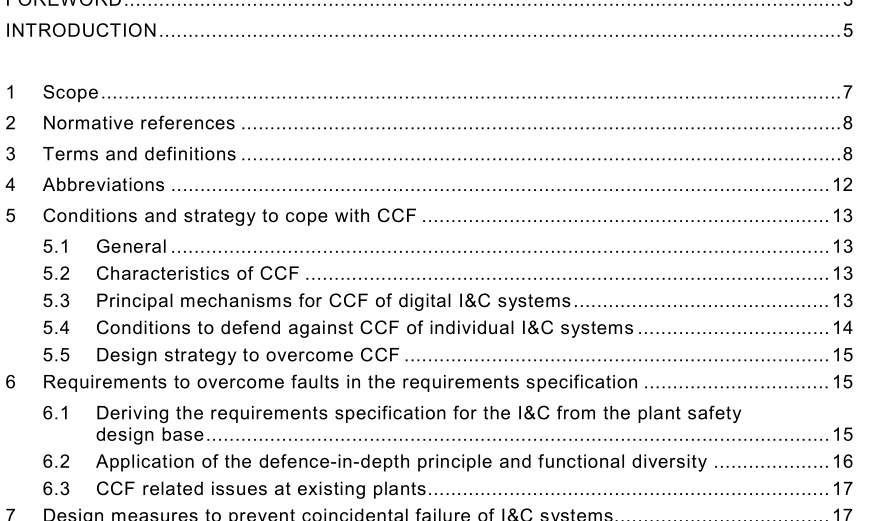IEC 62340-2007 pdf Nuclear power plants – Instrumentation and control systems important to safety – Requirements for coping with common cause failure (CCF)

3.1 5 random fault non-systematic fault of hardware components NOTE Faults of hardware components are a consequence of physical or chemical effects, which may occur at any time. A good description of the probability of the occurrence of random faults can be given using statistics (fault rate). Increased fault rates may be the consequence of systematic faults in hardware design or manufacture, if these occur without temporal correlation, for example as a consequence of premature ageing. 3.1 6 signal trajectory time histories of all equipment conditions, internal states, input signals and operator inputs which determine the outputs of a system [IEC 60880, 3.33] 3.1 7 single failure a failure which results in the loss of capability of a system or component to perform its intended safety function(s), and any consequential failure(s) which result from it [IAEA Safety Glossary, Ed. 2.0, 2006] 3.1 8 single-failure criterion a criterion (or requirement) applied to a system such that it must be capable of performing its task in the presence of any single failure [IAEA Safety Glossary, Ed. 2.0, 2006] NOTE See also ”single failure”, “software failure”. 3.1 9 software failure system failure due to the activation of a design fault in a software component [IEC 61 51 3, 3.57] NOTE 1 All software failures are due to design faults, since software does not wear out or suffer from physical failure. Since the triggers which activate software faults are encountered at random during system operation, software failures also occur randomly. NOTE 2 See also ”failure, fault, software fault”.
For I&C systems that perform category A functions the appropriate application of redundancy combined with voting mechanisms has been proven to meet the single failure criterion. This design ensures that the likelihood of a failure of such I&C systems is very low. I&C systems with this design can fail if two or more redundant channels fail concurrently (CCF). The CCF can occur if a latent fault is systematically incorporated in some or all redundant channels and if by a specific event this fault is triggered to cause the coincidental failure of some or all channels. A redundant I&C system fails if the number of faulted channels exceeds its design limit.
- Previous:IEC 62374-2007 pdf Semiconductor devices – Time dependent dielectric breakdown (TDDB) test for gate dielectric films
- Next:IEC 62271-112-2013 pdf High-voltage switchgear and controlgear – Part 112: Alternating current high-speed earthing switches for secondary arc extinction on transmission lines
- ISO IEC 27050-4-2021 pdf Information technology — Electronic discovery — Part 4: Technical readiness
- ISO IEC 27036-1-2021 pdf Cybersecurity — Supplier relationships — Part 1: Overview and concepts
- ISO IEC 27013-2021 pdf Information security, cybersecurity and privacy protection — Guidance on the integrated implementation of ISO/IEC 27001 and ISO/IEC 20000-1
- ISO IEC 26580-2021 pdf Software and systems engineering — Methods and tools for the feature- based approach to software and systems product line engineering
- ISO IEC 24735-2021 pdf Information technology — Office equipment — Method for measuring digital copying productivity
- ISO IEC 24711-2021 pdf Information technology — Office equipment — Method for the determination of ink cartridge yield for colour inkjet printers and multi- function devices that contain printer components
- ISO IEC 23544-2021 pdf Information Technology — Data centres — Application Platform Energy Effectiveness (APEE)
- ISO IEC 23510-2021 pdf Information technology — 3D printing and scanning — Framework for an Additive Manufacturing Service Platform (AMSP)
- ISO IEC 23127-1-2021 pdf Information technology — Learning, education, and training — Metadata for facilitators of online learning — Part 1: Framework
- ISO IEC 23126-2021 pdf Information technology for learning, education and training — Ubiquitous learning resource organization and description framework
- IEC 60034-5-2006 pdf Rotating electrical machines – Part 5: Degrees of protection provided by the integral design of rotating electrical machines (IP code) – . Classification
- IEC TR 63335-2021 pdf Nuclear power plants – Instrumentation and control systems, control rooms and electrical power systems – Specific features of small modular reactors and needs regarding standards
- IEC TS 63217-2021 pdf Utility-interconnected photovoltaic inverters – Test procedure for over voltage ride-through measurements
- ISO IEC 23127-1-2021 pdf Information technology — Learning, education, and training — Metadata for facilitators of online learning — Part 1: Framework
- IEC 61169-15-2021 pdf Radio-frequency connectors – Part 15: Sectional specification – RF coaxial connectors with inner diameter of outer conductor 4,13 mm (0,163 in) with threaded coupling – Characteristic impedance 50 Ω (type SMA)
- BS ISO IEC 15420-2009 pdf Information technology一 Automatic identification and data capture techniques EAN/UPC bar code symbology specification
- BS ISO IEC 19762.5-2008 pdf Information technology一 Automatic identification and data capture (AIDC) techniques – Harmonized vocabulary Part 5: Locating systems
- BS IEC 60860-2014 pdf Radiation protection instrumentation一 Warning equipment for criticality accidents
- ISO IEC 24735-2021 pdf Information technology — Office equipment — Method for measuring digital copying productivity
- ISO IEC 24711-2021 pdf Information technology — Office equipment — Method for the determination of ink cartridge yield for colour inkjet printers and multi- function devices that contain printer components